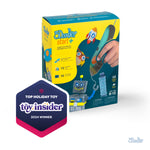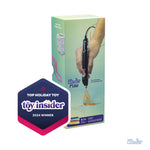Upcycle with 3Doodler
In this activity, students will work together to design and create upcycled products using objects collected at home and in school. Thinking creatively and fluently, students will design a new product with a specific purpose(s) composed of 1-3 objects and enhanced by the 3Doodler. *This activity is based on the Guilford Test, which tests creativity in brainstorming alternative uses for everyday objects.

KnowledgeStudents havehad practice brainstorming ideas.
had practice with the 3Doodler.
had practice brainstorming ideas.
had practice with the 3Doodler.
ObjectivesStudents willidentify and practice flexible thinking.
analyze attributes of objects.
upcycle everyday objects as components of a larger product with a purpose(s).
exercise fluent and original thinking by examining alternative uses for combined objects.
use the 3Doodler to assemble or create parts for a repurposed object.
identify and practice flexible thinking.
analyze attributes of objects.
upcycle everyday objects as components of a larger product with a purpose(s).
exercise fluent and original thinking by examining alternative uses for combined objects.
use the 3Doodler to assemble or create parts for a repurposed object.
MaterialsStudents will need3Doodler START (1 per group)
pencil (1 per students)
scrap paper (1 per student)
white copy paper (1 sheet per student)
table set up with everyday objects, e.g., mugs, bricks, paperclips, toothpicks, paper cups, tin cans, books, rulers, scissors, paper towel rolls, metal clothes hangers, pencils, shoes, keys, buttons, corks, paper clips, pencils, erasers, egg carton, binder clips, etc.
3Doodler START (1 per group)
pencil (1 per students)
scrap paper (1 per student)
white copy paper (1 sheet per student)
table set up with everyday objects, e.g., mugs, bricks, paperclips, toothpicks, paper cups, tin cans, books, rulers, scissors, paper towel rolls, metal clothes hangers, pencils, shoes, keys, buttons, corks, paper clips, pencils, erasers, egg carton, binder clips, etc.
Lesson PlanInstructions
Step 1PREPARATION
Set up table with objects before this session.
Step 2Display ordinary paper clip. Ask students to explain the common purpose of a paper clip, i.e., to hold papers together.
Step 3Generate a list of alternative uses for a paperclips as earrings, cufflinks, or a key to unlock a door. Demonstrate how. (Optional: More uses for paperclip: http://www.xrysostom.com/paperclip.html)
Step 4Divide students into groups of 3-4. Pass out the same object to each group, e.g., scissors, along with scrap paper and pencils.
Instruct students to
a) list the objects' real purpose, and
b) list alternative uses for the same object. The goal is to come up with as many alternative uses as possible.
Step 5Sort students' ideas under the proper T-Chart heading: "Possible" or "Impossible." Have students differentiate between the two.
Step 6Share the goal: "Upcycle 1-3 combined objects as a new product as a prototype using the 3Doodler.
Explain terminology:
prototype: a first model of something from which other forms are developed or copied.
upcycle: reuse (discarded objects or material) in such a way as to create a product of a higher quality or value than the original.
Step 7Students will upcycle 1-3 combined object(s) by
(a) analyzing object(s) for possible defects,
(b) analyzing the attributes of object(s), e.g., shape, size, etc.
(c) analyzing existing purposes of an object(s) and how to improve them, or
(d) coming up with new ways to use object(s).
Step 8Share and discuss Ways to Change an Object's Design or Purpose List. (See Resources.)
Step 9Demonstrate process using three objects: pencil, eraser binder clip and post its. Discuss real purpose of each object. Ask: "What additional problems could I solve with these 3 items combined?"

![]()
![]() Step 10
Step 10Brainstorm and list as many ideas as possible. Draw a sketch. Use 3Doodler to combine and/or add to items.

![]()
![]() Step 11
Step 11Hand out 2-3 objects to each group. Prompt students to brainstorm ideas, create a sketch, get it approved and move onto 3Doodling. *Note that their models will be prototypes, so they should be handled with care.
Circle to assist and assess.
PREPARATION
Set up table with objects before this session.
Display ordinary paper clip. Ask students to explain the common purpose of a paper clip, i.e., to hold papers together.
Generate a list of alternative uses for a paperclips as earrings, cufflinks, or a key to unlock a door. Demonstrate how. (Optional: More uses for paperclip: http://www.xrysostom.com/paperclip.html)
Divide students into groups of 3-4. Pass out the same object to each group, e.g., scissors, along with scrap paper and pencils.
Instruct students to
a) list the objects' real purpose, and
b) list alternative uses for the same object. The goal is to come up with as many alternative uses as possible.
Sort students' ideas under the proper T-Chart heading: "Possible" or "Impossible." Have students differentiate between the two.
Share the goal: "Upcycle 1-3 combined objects as a new product as a prototype using the 3Doodler.
Explain terminology:
prototype: a first model of something from which other forms are developed or copied.
upcycle: reuse (discarded objects or material) in such a way as to create a product of a higher quality or value than the original.
Students will upcycle 1-3 combined object(s) by
(a) analyzing object(s) for possible defects,
(b) analyzing the attributes of object(s), e.g., shape, size, etc.
(c) analyzing existing purposes of an object(s) and how to improve them, or
(d) coming up with new ways to use object(s).
Share and discuss Ways to Change an Object's Design or Purpose List. (See Resources.)
Demonstrate process using three objects: pencil, eraser binder clip and post its. Discuss real purpose of each object. Ask: "What additional problems could I solve with these 3 items combined?"

Brainstorm and list as many ideas as possible. Draw a sketch. Use 3Doodler to combine and/or add to items.

Hand out 2-3 objects to each group. Prompt students to brainstorm ideas, create a sketch, get it approved and move onto 3Doodling. *Note that their models will be prototypes, so they should be handled with care.
Circle to assist and assess.
Wrap Up
Assessment
Possible Extensions
Resources
Ways to change an object's function/purpose
merge surfaces with another object
add motion, e.g., wheels, fan, etc.
add light, e.g., circuits with LEDs
add parts that require human generated power, e.g., crank, gears, etc.
physically attach parts
make attachments that are removable
offer optional parts
create a base
use recycled materials
take object apart (if possible)
animate the object (anthropomorphic)
add attachments to make wearable
extend it surface
hollow object (if possible)
bend, roll, twist, stack, rotate, flatten
change texture
cover or wrap object
elevate or lower object
expose its interior
add compartments
Vocabulary
antiquated - old-fashioned or outdated.
prototype - a first model of something from which other forms are developed or copied.
upcycle - reuse (discarded objects or material) in such a way as to create a product of a higher quality or value than the original.
Educational Standards
Engage effectively in a range of collaborative discussions (one-on-one, in groups, and teacher-led) with diverse partners on grade 4 topics and texts, building on others' ideas and expressing their own clearly.
Students will work in small groups to brainstorm, design and create repurposed object.
Pose and respond to specific questions to clarify or follow up on information, and make comments that contribute to the discussion and link to the remarks of others.
Each group must respond to questions to clarify or follow up on information about their product. Students must ask specific and relevant questions about other group's products.
Engineering Design Define a simple design problem reflecting a need or a want that includes specified criteria for success and constraints on materials, time, or cost.
Students will sketch, design and create a repurposed object. Students will consider the shape of the objects used when determining purpose.
Engineering Design Generate and compare multiple possible solutions to a problem based on how well each is likely to meet the criteria and constraints of the problem.
Students will brainstorm various possible uses for object(s) based on how well each is likely to meet the criteria and constraints of this activity's challenge.
Decompose (break down) a larger problem into smaller sub-problems with teacher guidance or independently.
Students will brainstorm ideas and sketch a design to illustrate their group's thoughts and ideas.
Decompose (break down) a larger problem into smaller sub-problems with teacher guidance or independently.
Students will break down the process into brainstorming, designing, building, testing, presenting to group.
Exhibit a tolerance for ambiguity, perseverance and the capacity to work with open-ended problems.
Students will demonstrate willingness and competency within an open-ended task with more than one possible outcome.
Create original works or responsibly repurpose or remix digital resources into new creations.
Students will remix object(s) to create a new object with an alternate or improved usage.
Use collaborative technologies to work with others, including peers, experts or community members, to examine issues and problems from multiple viewpoint
Students will seek feedback from peers before and during design phase of this project.
Use technology to seek feedback that informs and improves their practice and to demonstrate their learning in a variety of ways.
Students will use the 3Doodler to create repurposed objects that may accomplish a purpose.





